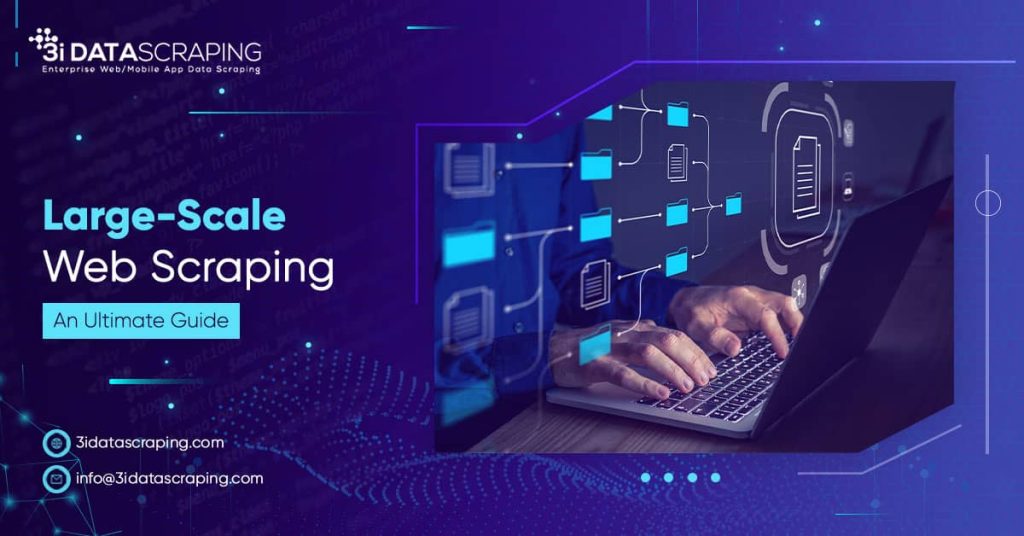Large-Scale Web Scraping: An Ultimate Guide
Today, web extraction has become an essential part of businesses. With this comes several myths and legalities leading to doubts and debates. As such, learn about these myths and more through the guide.
- February 24, 2023
Our achievements in the field of business digital transformation.









The Internet is a vast place. There are billions of users who produce immeasurable amounts of data daily. Retrieving this data requires a great deal of time and resources.
To make sense of all that information, we need a way to organize it into something meaningful. That is where large-scale web scraping comes to the rescue. It is a process that involves gathering data from websites, particularly those with large amounts of data.
In this guide, we will go over all the core concepts of large-scale web scraping and learn everything about it, from challenges to best practices.
What Is Large-Scale Web Scraping?
Large Scale Web Scraping is scraping web pages and extracting data from them. This can be done manually or with automated tools. The extracted data can then be used to build charts and graphs, create reports and perform other analyses on the data.
It can be used to analyze large amounts of data, like traffic on a website or the number of visitors they receive. In addition, It can also be used to test different website versions so that you know which version gets more traffic than others.
Large Scale Web Scraping is an essential tool for businesses as it allows them to analyze their audience’s behavior on different websites and compare which performs better.
3 Major Challenges In Large Scale Web Scraping
Large-scale scraping is a task that requires a lot of time, knowledge, and experience. It is not easy to do, and there are many challenges that you need to overcome to succeed.
1. Performance
Performance is one of the significant challenges in large-scale web scraping.
The main reason for this is the size of web pages and the number of links resulting from the increased use of AJAX technology. This makes it difficult to scrape data from many web pages accurately and quickly.
Another factor affecting performance is the type of data you seek from each page. If your search criteria are particular, you may need to visit many pages to get what you are up to.
2. Web Structure
Web structure is the most crucial challenge in scraping. The structure of a web page is complex, and it is hard to extract information from it automatically. This problem can be solved using a web crawler explicitly developed for this task.
3. Anti-Scraping Technique
Another major challenge when you want to scrape the website at a large scale is anti-scraping. It is a method of blocking the scraping script from accessing the site.
If a site’s server detects that it has been accessed from an external source, it will respond by blocking access to that external source and preventing scraping scripts from accessing it.
What Are The Best Practices for Large Scale Web Scraping

Large-scale web scraping requires a lot of data and is challenging to manage. It is not a one-time process but a continuous one requiring regular updates. Here are some of the best practices for large-scale web scraping:
1. Create Crawling Path
The first thing to scrape extensive data is to create a crawling path. Crawling is systematically exploring a website and its content to gather information.
The most common method of crawling is Web Scraping, where you will use a tool like Scrapebox, ScraperWiki, or Scrapy to automate the process of scraping the Web.
You can also create a crawl path manually by copying and pasting URLs into software like ScraperWiki or Scrapy and then using it to generate data from the source website.
2. Data Warehouse
The data warehouse is a storehouse of enterprise data that is analyzed, consolidated, and analyzed to provide the business with valuable information.
A data warehouse is an essential tool for large-scale web scraping, as it provides a central location where you can analyze and cleanse large amounts of data.
Suppose you need to become more familiar with the data warehouse concept. In that case, it is an organized collection of structured data in one place that you can use to perform analytics and business reporting.
3. Proxy Service
Proxy service is a great way to scrape large-scale data. It can be used for scraping images, blog posts, and other types of data from the Internet.
It allows you to hide your computer IP address by replicating it on another server and sending the requests to that server.
This is very effective as you need help tracking because hundreds of servers feed you with data. You can also use this method to scrape data from a website not owned by the company or person who owns that website.
4. Detecting Bots & Blocking
Bots are a real problem for scraping. They are used to extract data from websites and make it available for human consumption. They do this by using software designed to mimic a human user so that when the bot does something on a website, it looks like a real human user is doing it.
The best way to detect bots is by using a crawling library. This is the most crucial step in the process. The list of libraries is endless, but a few of the most popular ones are Scrapy, ScrapySpider, and Selenium WebDriver. If you do not detect bots and blocking, your scrapers will be blocked by any website owner who does not want their website to be crawled.
5. Handling Captcha
Captcha is a test you must do to get access to the website. It is usually a picture, but sometimes it’s a text-based captcha.
If you are scraping from a website, you should be able to make your scraper skip this step. But if it is not possible, there are some things you can do about it. You can use various proxies types, regional proxies, and more.
Moreover, there are libraries like reCaptcha and recaptcha Scrabble that will solve all of your problems. You must add them as an option in your code and then use them as needed. This can be useful if you are scraping on an API that does not support solving captchas (like Twitter).
6. Maintenance Performance
Whenever you scrape many web pages, it is essential to maintain the performance of your scraping code.
This means that you should only scrape from a single location at a time and only crawl a few pages in parallel. If you have many scrapes at once, your scraper’s performance will hit a wall and become difficult to run.
In addition, when using scrapers like PhantomJS or Selenium, they must be able to handle slow requests without causing errors or timing out.
Some browsers may not allow scripts to load from other domains, so use absolute paths for your script files and try using localStorage if possible (this can be disabled in many browsers).
Getting To Know The Client Expectations And Needs
We collect all the data from our clients to analyze the feasibility of the data extraction process for every individual site. If possible, we tell our clients exactly what data can be extracted, how much can be extracted, to what extent it can be extracted, and how much time the process completes.
Constructing Scrapers And Assembling Them Together
For every site allotted to us by our clients, we get a unique scraper built in place so that no one scraper has the burden to go through thousands of sites and millions of data. Moreover, all those scrapers are working in tandem for work to be done rapidly.
Running The Scrapers By Executing Them Smoothly
It is essential to have the servers and Internet lease lines running all the time so the extraction process is not interrupted. We ensure this through high-end hardware present at our premises costing lacs of rupees so that real-time information is delivered after extraction whenever the client wants. To avoid any blacklisting scenario, we already have proxy servers, many IP addresses, and various secret strategies coming to our rescue.
Quality Checks Scrapers Maintenance Performed On A Regular Basis
After the the automated web data scraping process, we ensure manual quality checks on the extracted or mined data via our QA team, who constantly communicates with the developer’s team for any bugs or errors reported. Additionally, if the scrapers need to be modified per changing site structure or client requirements, we do so without any hassle.
Final Thoughts
So, here you have learned everything about large-scale web scraping, from challenges to some of the best practices of web scraping at scale.
We have covered all the topics in this article, so we hope you have learned something new. Now it is time to apply what you have learned and start scraping data from the Web independently.
Be careful to use all technology sparingly because many different tools are available today, each with pros and cons. So, choose your tool wisely, depending on your needs.














What Will We Do Next?
- Our representative will contact you within 24 hours.
- We will collect all the necessary requirements from you.
- The team of analysts and developers will prepare estimation.
- We keep confidentiality with all our clients by signing NDA.





